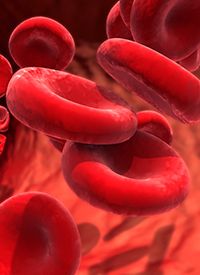Article
Ruxolitinib Induces High Responses in SR-aGVHD, Regardless of Cytopenias
Author(s):
The presence of cytopenias did not affect the favorable and durable responses seen with ruxolitinib vs best available therapy in patients with steroid-refractory acute graft-vs-host disease.
Design Cells - stock.adobe.com

The presence of cytopenias did not affect the favorable and durable responses seen with ruxolitinib (Jakafi) vs best available therapy (BAT) in patients with steroid-refractory acute graft-vs-host disease (SR-aGVHD), according to a post hoc analysis of the REACH2 trial (NCT029132561) presented at the 2023 Transplantation & Cellular Therapy Meetings.1
The analysis showed that ruxolitinib elicited higher responses at day 28 compared with BAT in most cytopenia-based subgroups and had durable responses at day 56. Similar blood counts during early treatment were also seen with ruxolitinib and BAT.
In REACH2, a randomized, open-label phase 3 study, ruxolitinib demonstrated higher overall response rates (ORRs) vs BAT in patients 12 years or older with grade II to IV SR-aGVHD at day 28 (62% vs 39%, respectively).2
“Thrombocytopenia and anemia were the most common adverse events [AEs] with ruxolitinib, consistent with previous studies in myeloproliferative neoplasms and the role of JAK2 in hematopoiesis,” the investigators wrote in their poster presentation.1 “Thus, outcomes of REACH2 patients who developed clinically relevant cytopenias need further validation.”
Of the 302 patients included in the safety analysis, 152 were randomly assigned to 10 mg of oral ruxolitinib twice daily and 150 were assigned to 1 of 9 BAT options. Investigators of the post hoc analysis looked at ORR at day 28, duration of response (DOR), durable responses at day 56 in patients who responded by day 28 by platelet counts (PLT), white blood cell counts (WBC), hemoglobin (Hb), and absolute neutrophil counts (ANC). Cytopenia subgroups were defined by the presence or absence of 1 or more low ANC, Hb, PLT, or WBC measure between baseline and week 4 (categorized as low or not low, respectively).
Irrespective of low or not low PLT, WBC, ANC, or low Hb concentration, the ORR at day 28 was higher with ruxolitinib vs BAT. The higher ORR for ruxolitinib was statistically significant compared with BAT as indicated by the odds ratios (ORs) for overall patient population (OR, 2.6; 95% CI, 1.7-4.2), ANC (low OR, 5.2; 95% CI, 2.0-13.7; not low OR, 2.0; 95% CI; 1.2-3.5), PLT (OR, 2.6; 95% CI, 1.3-5.0; not low OR, 2.5; 95% CI; 1.3-4.9), and low WBC (OR, 2.7; 95% CI, 1.6-4.6) categories.
Durable responses were seen at day 56 in all subgroups of patients who responded by day 28. There was also a numerically longer duration of response with ruxolitinib for both PLT, both Hb, low WBC, and not low ANC subgroups.
Through week 24, the mean PLT counts and Hb concentrations were similar for the ruxolitinib and BAT groups. They decreased in the first 4 to 8 weeks of therapy, then recovered after. Likewise, the WBC and ANC decreased through week 8 and remained lower in patients receiving ruxolitinib compared with BAT at week 24.
Within the first 4 weeks of therapy, the median ruxolitinib dose intensity was 20 mg/d or near 20 mg/d in all subgroups regardless of cytopenia status (subgroups range, 18.5-20.0 mg/d).
“Ruxolitinib and BAT were associated with similar reductions in blood counts early in treatment, highlighting the potential myelosuppressive effects of aGVHD development vs the impact of treatment on blood counts,” the investigators concluded.
References
- Mahmoudjafari Z, Socie G, Bhatt V, Galvin J, Xue Z, Mohty M. Impact of cytopenias in patients treated with ruxolitinib versus best available therapy for steroid-refractory acute graft-versus-host disease: A REACH2 post hoc analysis. Presented at: 2023 Transplantation & Cellular Therapy Meetings; Orlando, FL; February 15-19, 2023. Poster 344.
- Zeiser R, von Bubnoff N, Butler J, et al. Ruxolitinib for glucocorticoid-refractory acute graft-versus-host disease. N Engl J Med. 2020;382(19):1800-1810. doi:10.1056/NEJMoa1917635









